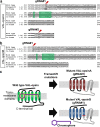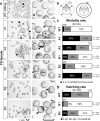Deep Brain Photoreceptor (val-opsin) Gene Knockout Using CRISPR/Cas Affects Chorion Formation and Embryonic Hatching in the Zebrafish
- PMID: 27792783
- PMCID: PMC5085036
- DOI: 10.1371/journal.pone.0165535
Deep Brain Photoreceptor (val-opsin) Gene Knockout Using CRISPR/Cas Affects Chorion Formation and Embryonic Hatching in the Zebrafish
Abstract
Non-rod non-cone photopigments in the eyes and the brain can directly mediate non-visual functions of light in non-mammals. This was supported by our recent findings on vertebrate ancient long (VAL)-opsin photopigments encoded by the val-opsinA (valopa) and val-opsinB (valopb) genes in zebrafish. However, the physiological functions of valop isoforms remain unknown. Here, we generated valop-mutant zebrafish using CRISPR/Cas genome editing, and examined the phenotypes of loss-of-function mutants. F0 mosaic mutations and germline transmission were confirmed via targeted insertions and/or deletions in the valopa or valopb gene in F1 mutants. Based on in silico analysis, frameshift mutations converted VAL-opsin proteins to non-functional truncated forms with pre-mature stop codons. Most F1 eggs or embryos from F0 female valopa/b mutants showed either no or only partial chorion elevation, and the eggs or embryos died within 26 hour-post-fertilization. However, most F1 embryos from F0 male valopa mutant developed but hatched late compared to wild-type embryos, which hatched at 4 day-post-fertilization. Late-hatched F1 offspring included wild-type and mutants, indicating the parental effects of valop knockout. This study shows valop gene knockout affects chorion formation and embryonic hatching in the zebrafish.
Conflict of interest statement
The authors have declared that no competing interests exist.
Figures






Similar articles
-
Brain area-specific diurnal and photic regulation of val-opsinA and val-opsinB genes in the zebrafish.J Neurochem. 2015 May;133(4):501-10. doi: 10.1111/jnc.13084. Epub 2015 Mar 17. J Neurochem. 2015. PMID: 25727787
-
Localization and characterization of val-opsin isoform-expressing cells in the brain of adult zebrafish.J Comp Neurol. 2014 Dec 1;522(17):3847-60. doi: 10.1002/cne.23645. Epub 2014 Aug 11. J Comp Neurol. 2014. PMID: 25043553
-
Differential expression of duplicated VAL-opsin genes in the developing zebrafish.J Neurochem. 2008 Mar;104(5):1364-71. doi: 10.1111/j.1471-4159.2007.05093.x. Epub 2007 Nov 23. J Neurochem. 2008. PMID: 18036148 Free PMC article.
-
Understanding and Editing the Zebrafish Genome.Adv Genet. 2015;92:1-52. doi: 10.1016/bs.adgen.2015.09.002. Epub 2015 Nov 12. Adv Genet. 2015. PMID: 26639914 Review.
-
Genome editing using artificial site-specific nucleases in zebrafish.Dev Growth Differ. 2014 Jan;56(1):26-33. doi: 10.1111/dgd.12094. Epub 2013 Oct 14. Dev Growth Differ. 2014. PMID: 24117409 Review.
Cited by
-
Phenogenetics of cortical granule dynamics during zebrafish oocyte-to-embryo transition.Front Cell Dev Biol. 2025 Jan 30;13:1514461. doi: 10.3389/fcell.2025.1514461. eCollection 2025. Front Cell Dev Biol. 2025. PMID: 39949602 Free PMC article. Review.
-
CRISPR/Cascade 9-Mediated Genome Editing-Challenges and Opportunities.Front Genet. 2018 Jul 5;9:240. doi: 10.3389/fgene.2018.00240. eCollection 2018. Front Genet. 2018. PMID: 30026755 Free PMC article. Review.
-
Membrane progesterone receptor e (paqr9) is necessary for chorion elevation in zebrafish.Fish Physiol Biochem. 2025 Feb;51(1):1. doi: 10.1007/s10695-024-01435-1. Epub 2024 Dec 6. Fish Physiol Biochem. 2025. PMID: 39643858
-
Application of CRISPR/Cas9 Technology in Cancer Treatment: A Future Direction.Curr Oncol. 2023 Feb 6;30(2):1954-1976. doi: 10.3390/curroncol30020152. Curr Oncol. 2023. PMID: 36826113 Free PMC article. Review.
-
Characterization of tmt-opsin2 in Medaka Fish Provides Insight Into the Interplay of Light and Temperature for Behavioral Regulation.Front Physiol. 2021 Oct 22;12:726941. doi: 10.3389/fphys.2021.726941. eCollection 2021. Front Physiol. 2021. PMID: 34744767 Free PMC article.
References
-
- Nakane Y, Ikegami K, Ono H, Yamamoto N, Yoshida S, Hirunagi K, et al. A mammalian neural tissue opsin (Opsin 5) is a deep brain photoreceptor in birds. Proceedings of the National Academy of Sciences of the United States of America. 2010;107(34):15264–8. Epub 2010/08/04. 10.1073/pnas.1006393107 - DOI - PMC - PubMed
MeSH terms
Substances
LinkOut - more resources
Full Text Sources
Other Literature Sources
Molecular Biology Databases
Research Materials

